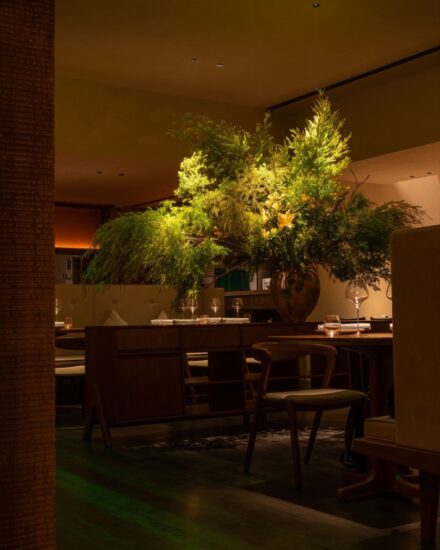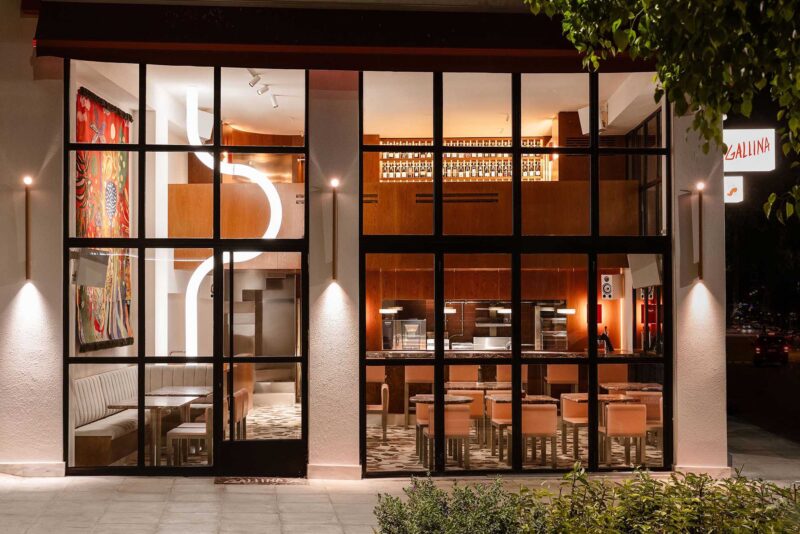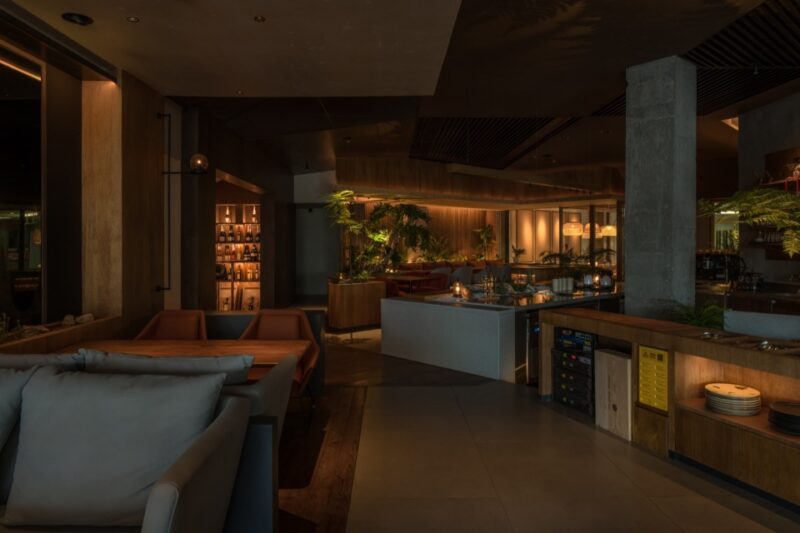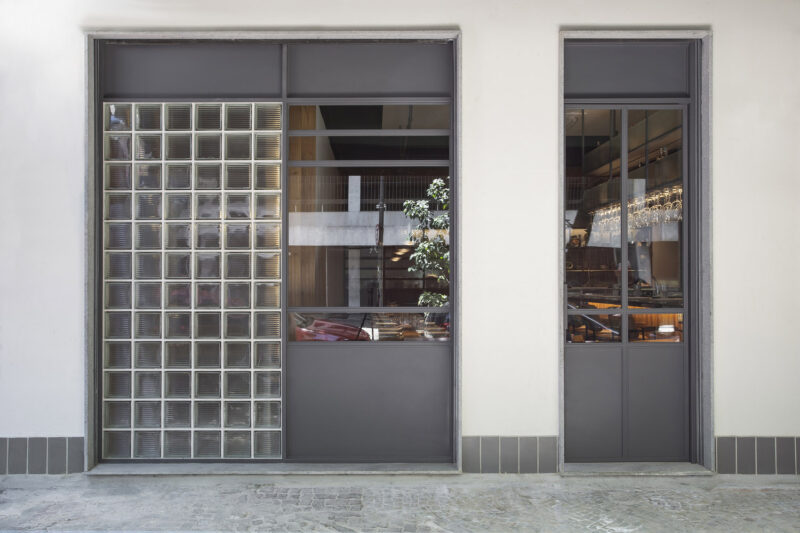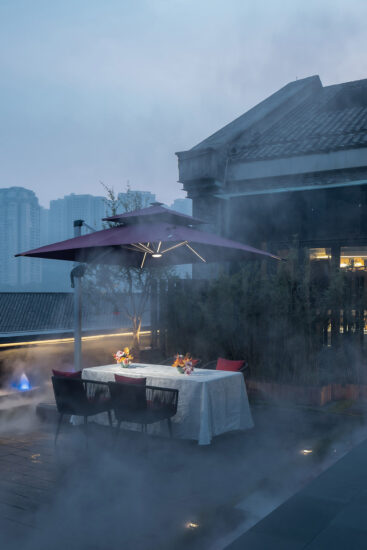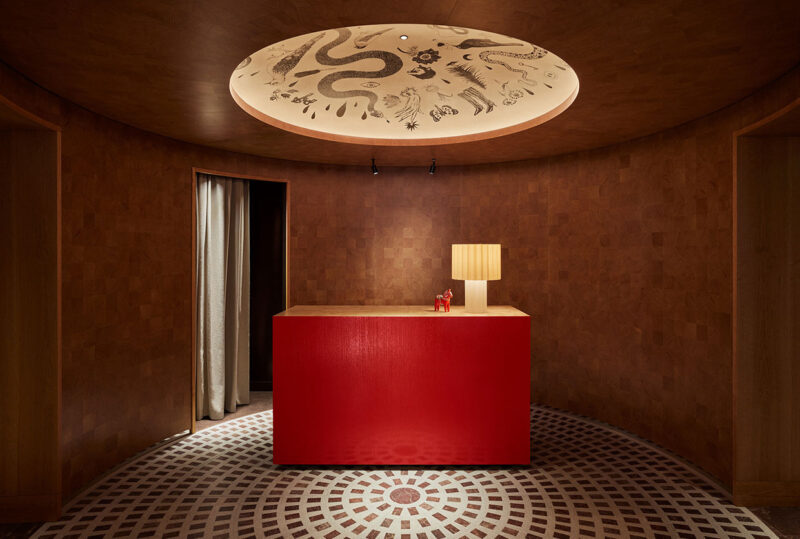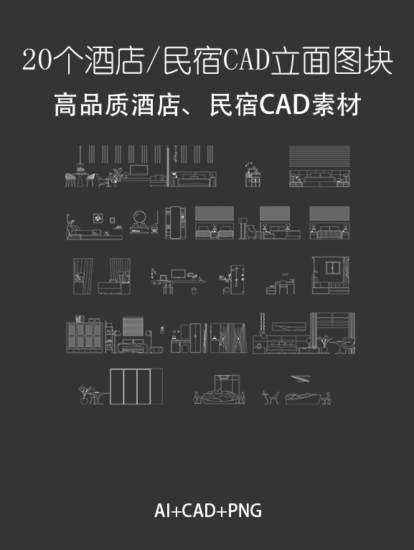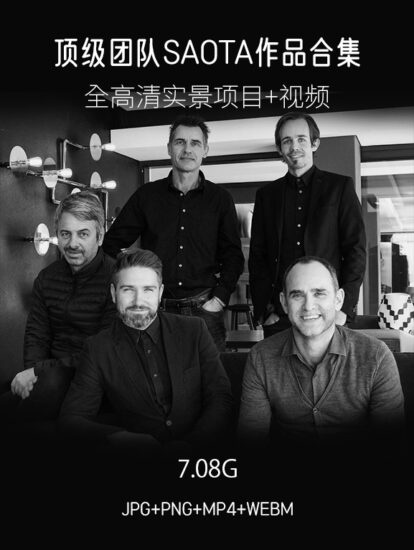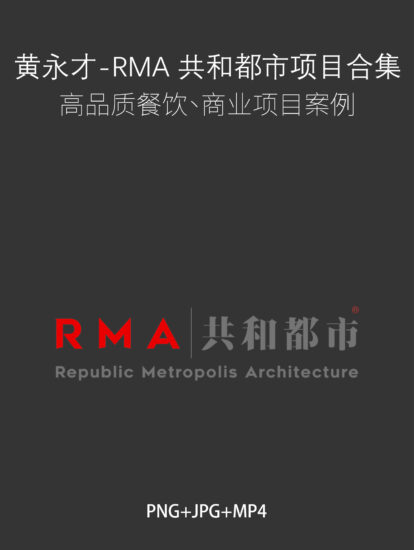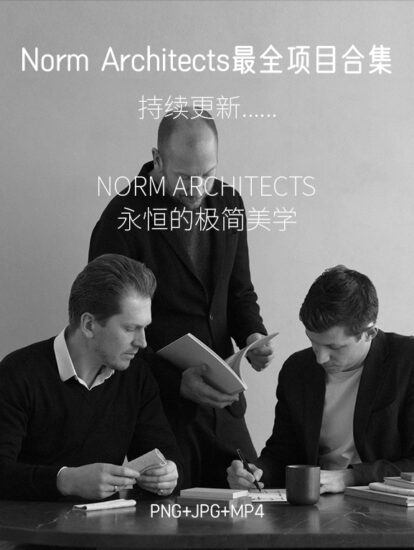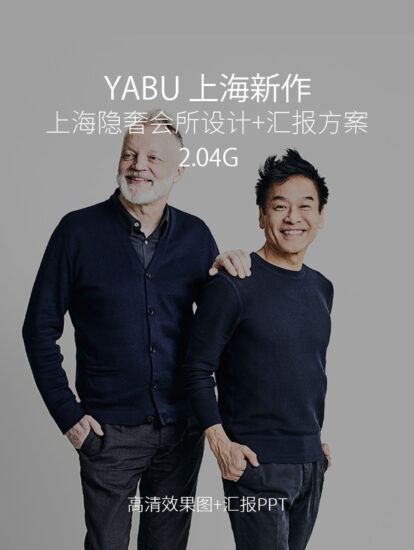棲霞坑村位於奉化溪口鎮,是棲霞坑古道的起始點。狹窄古道密林遮道,群山環抱,峽穀幽長,原稱桃花坑,後改名為棲霞坑,一到秋天,滿山的紅楓秋葉。村子處於山坳之中,民居沿著溪流兩側分布,小橋流水、清泉溪流、古樹古橋、炊煙嫋嫋,很有江南古村落的韻味。
Qixiakeng Village, located in Xikou Town, Fenghua, is the entrance to the ancient Qixiakeng Road. The narrow alley, covered in dense forests and surrounded by mountains and long canyons, was originally named Peach Blossom Pit. Its name later changed into Qixiakeng (Resting Pit for glowing coulds) as in autumn, the mountains are all covered with red maple leaves, as if cast by the rosy sunset. The village is located in the valley with residential buildings along both sides of the stream. The stream under tiny pons, clear springs in running brooks, ancient trees and the arising mist consist the charm of the ancient Jiangnan village.
∇ 俯瞰餐廳與村落的關係 Overlooking the restaurant and the village ©尌林建築
自駕前往棲霞坑村,下高速之後途經一段山路,環繞水庫十幾分鍾,沿途並無村莊。天氣好的時候湖麵波光粼粼,遠山環抱,很是美好。
If you self-drive to Qixiakeng Village, you will get off the expressway, pass through mountain road, circle around the reservoir for ten minutes with no villages to be seen. If you are lucky, you will also enjoy the picturesque view of the sparkling lake and surrounding mountains in the distance.
∇ 透過橋洞看餐廳 Restaurant though the bridge ©吳昂
餐廳作為整村文旅民宿綜合體配套公區的一部分,位於進村就能看到的溪邊,由一個發電站改造加建而成。進村道路不寬,隻有3米多,一側是高起來的地形石坎,為保持街道的整體性,我們將建築的外邊界線控製在老建築的邊界內。餐廳的正立麵朝向村道,建築的一層用整體的大玻璃麵向街道打開,沿用老房子的界麵往裏退讓。大玻璃麵讓建築的一層空間和街道之間發生更多緊密的關係,裏外互動,空間滲透。同時過往的路人也能輕鬆的關注到餐廳水吧空間,很自然得被吸引進來。
As a part of the supporting public area of the hotel complex, the restaurant is located by the stream right at the entrance to the village. It was rebuilt and reformed from a power station. The road into the village is not wide with only 3 meters length and a high rocky ridge on the one side. To keep the consistency, we made sure the outer boundary line of the building is within that of the old building. The restaurant faces the village road in the front, and the first floor is opened to the street through a whole large glass door, which gives way to the front of the old residential buildings. The glass surface creates a closer relationship between the first-floor space and the street for interaction and penetration. Meanwhile, passers-by will easily notice the water bar in the restaurant and be attracted.
∇ 溪邊的餐廳 Restaurant by the lake ©吳昂
生動 Vividness
餐廳建在溪邊一個梯形的地塊上,由於使用麵積緊張,我們選擇把建築的邊界撐滿了整個場地。因此建築的形體也是一個不規則的梯形,平麵上看隻有一個角是直角。屋頂的屋脊與道路的邊界平行,屋頂的簷口在一側水平,另一側則變成了“斜劉海”。這種屋頂形態在村裏也隨處可見,由於地形的關係許多老房子都采用這種斜的屋簷。不那麼正的屋簷與溪流及周邊的建築形成了非常生動有趣的關係,使餐廳猶如長久生長於此。
The restaurant is built on a trapezoidal plot beside the stream. Since there are not much space, we used the boundary of the building to the full. As a result, the building is in an irregular trapezoid, and only one corner is a right angle when viewed from the plane. The roof ridge is parallel to the boundary of the road, with the cornice of the roof horizontal on the one side and the other becoming “oblique bangs”. This kind of roof form can also be seen everywhere in the village because of the terrain. The crooked eaves form a vivid and interesting relationship with the stream and the surrounding buildings so that it seems the restaurant has been here from the beginning.
∇ 現場原始地形關係 The original terrain on site ©尌林建築
∇ 建築與村子的關係照片 Building and the village ©尌林建築
∇ 沿著溪邊布置的餐廳和老房子 Restaurants and old houses arranged along the stream ©吳昂
原場地的發電站是一個兩層的房子,體量關係敦實,與村落整體的氛圍有很大差異。於是我們選擇拆除發電站的上半部分,重新調整建築的層高,降低一層的高度,做成下沉式空間。建築頂部增加了一個半室外的空間,沒有封閉的立麵,同時在屋頂開了兩個大尺度的天窗,讓空間向自然敞開。同時也利用結構設計轉換,讓屋頂空間整體變輕。采用這種設計手法的緣由是遵循了村落環境所帶來的最直觀感受。
The original site of the power station is a two-story house with a solid volume relationship, which is quite different from the overall feature of the village. Therefore, we choose to demolish the upper part of the power station and changed the height by reducing the height of the first floor to make a sunken space. The half-open space on the rood made sure there is no close façade, while the two large-scale skylights are opened on the roof to make the space close to nature. Meanwhile, changes in structure is also used to make the roof lighter to follow the intuitive atmosphere brought by the village.
∇ 發電站原始樣貌 Photo of the original power station ©尌林建築
∇ 餐廳與旁邊民居的關係 Restaurant and its relationship with the residents ©吳昂
∇ 建築由重轉輕的形式關係 Structural format from heavy to light ©吳昂
∇ 建築立麵細節關係 Details on the façade relationship ©吳昂
轉換與連接 Conversion and connection
記憶的嫁接 Grafting of memory
發電站是村裏具有時代意義的一個符號。如今發電站已棄用多年,失去了功能性的使用價值。而將其改造成一個小酒吧與餐廳串聯起來,保留的發電機則作為一種凝結時間的象征。
The power station is a symbol of the time in the village. Nowadays, it has been abandoned for many years and lost its functional value. It is transformed into a small bar and connected with the restaurant, while the reserved generator is used as a symbol of condensed memory.
∇ 村裏民居類型調研 Investigation on the types of village dwellings ©尌林建築
記憶的留存是鄉村永恒的話題,沒有了記憶便沒有了文化。我們經常討論文化傳承,修複傳統建築保留其外殼或許是保留了物質遺產,但生活的記憶應由更具象征性的方式傳承。鄉村未來或許會進入預製化建造、節能環保、社區集中規劃等發展模式,但同質化、產品化是需要警惕的。因地製宜,製造差異化生活方式的場所,保持在地特征,是我們認為的更優的建設鄉村、傳承文化記憶的方式。
The retention of memory is an eternal topic for the countryside for without memory, there would be no culture. In terms of maintaining the cultural heritage, restoring traditional buildings and retaining their shells may suffice, but the memory of life should be passed on in a more symbolic way. In the future, the countryside may enter the development period of prefabricated construction, energy conservation and environmental protection, community centralized planning, etc., but homogenization and productization need to be vigilant. We think a better way to promote countryside development and inherit the cultural memory is to design architectures according to the local conditions and pass on memories with differentiated lifestyles and maintain local characteristics.
∇ 緊鄰村道的餐廳酒吧,Bar restaurant by the street ©吳昂
∇ 架在溪流邊的餐廳 Restaurant by the stream ©吳昂
∇ 改造後的發電站 Adapted power station ©吳昂
我們對村裏的老房子做了統計分析研究,發現了一種共性:大部分的形態邏輯和材料關係都是類似的。一層正立麵是木頭的牆體和門窗,填充在木結構內,上下分層的結構,中間會有一層單坡屋頂批簷,一層界麵內退,形成灰空間,二層平齊結構,但界麵都在大的簷口裏麵,考慮到雨水對木頭材料的損壞。在江浙一帶,木頭的部分多會在屋簷以內,避免被雨水直接淋到。
When researching on the old architectures in the village, we found them similar in the morphological logic and materials. The façade of the first floor, the wooden wall, doors and windows are filled in a wooden structure with upper and lower layers with a single-slope roof cornice in the middle. The first floor recedes to form a grey area. The second floor uses a flush structure, but the interface locates In the big cornice. Considering the damage of rain to wood materials. Most wooden structure in Jiangsu and Zhejiang provinces hide in the eaves to avoid being directly drenched by rain.
∇ 清晨的餐廳 Restaurant at dawn ©吳昂
結構的轉換 Changes in structure
我們希望餐廳的一層是一個無柱的大空間,為保證空間通透完整,結構上采用了結構柱錯位的方式,保證有兩個麵是完整的。建築二層的外立麵是通透的木框玻璃界麵,結構和立麵體係分離,門架式的鋼結構體係內退,落在一層的梁上。屋頂上鋼木結構混合搭接,實現鋼結構與木結構的融合與轉換。
We hope that the first floor of our restaurant is a large space without columns. In order to ensure the transparency and integrity, the columns are staggers so the two facades are kept complete. On the second floor, transparent wooden frame glass interface is used, which is separated from the system. The portal steel structure retreats and falls on the beam of the first floor. On the roof, the steel-wood structure is mixed and lapped to realize the fusion and conversion of steel and wood structure.
∇ 餐廳二層與半室外露台相連 Second floor of the restaurant connected to the terrace ©吳昂
發電站酒吧的基座標高很低,進入即是一個下沉式的環繞發電機的空間。利用高差關係,酒吧頂層做了一個半室外的活動空間,與餐廳二層相連,可做為餐廳空間的延伸,進行複合使用。外掛樓梯將酒吧和餐廳串聯起來,弱化了功能之間的邊界,使兩個空間既聯動又獨立,實現靈活使用,空間共享。
The power station bar has very low ground level with a sunken space around the generator. Based on the height difference, the top floor of the bar has a half-open activity space connected with the second floor and can be used as an extension of the space for comprehensive use. The external staircase connects the bar and restaurant, weakening the boundary between function areas, which makes sure the two spaces are both linked and independent for flexible use and sharing.
∇ 從溪流對岸看餐廳酒吧 View of the restaurant bar from the opposite bank of the stream ©吳昂
∇ 休閑酒吧外掛樓梯 Impending stairs out of the bar ©吳昂
∇ 餐廳臨街立麵 Street facade of restaurant ©吳昂
∇ 餐廳空間與村落互相滲透 The restaurant space permeates with the village ©吳昂
鄉村的未來一定是越來越多元化差異化,更加注重體驗。我們傾向於開放每個空間的使用功能的可能性,靈活多變或許能實現更高的利用率。從老房子到餐廳再到半室外露台空間,不同的空間狀態應生出不斷變化的身體體驗:人的身體從被包裹的狀態轉變成釋放的狀態,同時也契合了不同空間的使用屬性。建築時常觸發著不同的身心體驗,空間所表達出來的狀態不光是空間本身,也影響著人的感官體驗和行為經驗。
We believe that a future countryside is more diversified and differentiated with more attention to experience. Therefore, we want more possibility for functions of each space so that with such flexibility people use the space more often. From the old house to the dining room to the semi-outdoor terrace, different space should give birth to changing physical experiences: people’s bodies change from being wrapped to being released, which also fits in the different use of the space. Architecture often triggers various physical and mental experiences, and the space reveals not only itself, but also affects people’s sensory and behavioral experience.
∇ 連接餐廳二層的半室外空間 Half-open space on the second floor to connect the restaurant ©吳昂
∇ 開了大天窗的屋頂半室外空間 Half-open roof with large skylight open ©吳昂
∇ 開放的半室外露台空間 Terrace of the half-open space ©吳昂
∇ 半室外露台休閑座椅看山林 View of the mountain and forests from the half0open terrace ©吳昂
結構的轉換 Changes in structure
我們希望餐廳的一層是一個無柱的大空間,為保證空間通透完整,結構上采用了結構柱錯位的方式,保證有兩個麵是完整的。建築二層的外立麵是通透的木框玻璃界麵,結構和立麵體係分離,門架式的鋼結構體係內退,落在一層的梁上。屋頂上鋼木結構混合搭接,實現鋼結構與木結構的融合與轉換。
We hope that the first floor of our restaurant is a large space without columns. In order to ensure the transparency and integrity, the columns are staggers so the two facades are kept complete. On the second floor, transparent wooden frame glass interface is used, which is separated from the system. The portal steel structure retreats and falls on the beam of the first floor. On the roof, the steel-wood structure is mixed and lapped to realize the fusion and conversion of steel and wood structure.
∇ 一層水吧餐飲無柱大空間 The column-less space in the restaurant water bar on the first floor ©吳昂
∇ 餐廳一層水吧台 Water bar on the first floor of the restaurant ©吳昂
∇ 餐廳一層空間 Restaurant first-floor ©吳昂
∇ 陽光下的餐廳空間 restaurant in the sun ©吳昂
餐廳麵積不大,結構形式和建造關係卻相對複雜。酒吧空間保留了發電站厚實的混凝土基座,再用混凝土框架體係向上搭建。至屋頂層結構又轉換成了纖細的鋼構,立柱由一根大鋼柱拆分成兩根小的方鋼柱,使結構消隱。混凝土結構到鋼結構再到木結構,建築實現了由重到輕的結構轉化。鄉村建造讓我們更加大膽的去嚐試各種可能性,也讓建築的建造活動變得更加接近真實,更加契合當下鄉村的發展。
The restaurant features a small area but relatively complicated relationship between the structure and construction. The bar keeps the thick concrete base of the power station and is built up with a concrete frame system, which, as goes closer to the roof, changes into slender steel. A large steel column is split into two small square steel columns as support to conceal itself. From concrete to steel and then to wood structures, the building has realized the structural transformation from heavy to light. Rural construction makes us more daring to try various possibilities, and also makes the activities closer to reality, which is more in line with the current rural development.
∇ 二樓結構與立麵分離的餐廳室內空間 Indoor restaurant with structure separated from the façade ©吳昂
∇ 餐廳二層立麵開窗 Open windows on the second floor of the restaurant ©吳昂
∇ 餐廳局部 Details of restaurant first floor ©吳昂
∇ 輕巧的鋼結構轉換,與格柵形式語言一致 light conversion of the steel who speaks the same pattern language with the grille ©吳昂
看與被看 Seeing and being seen
與既有的環境互動,在無論麵積多小的建築中都是極其重要的。環境自有氣場,不同的周邊環境造就了不同的建築,忽視不同的場域所建造的建築隻能被稱為滿足使用需求的產品,而失去豐富多樣的生動可能。在豐富的環境條件下做建築是令人欣喜的,周邊的道路、樹木、溪流、古橋、老房子、竹林、山等,將周遭的這些要素都考慮到建築的設計中來,從而打造出表情多樣的充滿活力的建築。
However small the building is, it’s very important that it interacts with the surroundings. Surroundings create their own atmosphere for different buildings, while buildings that neglect the surroundings could only be called products to meet certain needs rather than vivid architectures. It’s enjoyable to make architectures in rich surroundings with roads, tree, streams, bridges, old houses, bamboo forests, mountains, etc., which are or considers into the designed to give life to the architecture.
∇ 相互連接的三棟建築 Three buildings interconncected ©吳昂
∇ 餐廳和老房子對話 Restaurant talks to the old building ©吳昂
“橋上的人在看風景,看風景的人在樓上看你”,事物之間相互依存、相互關聯,才讓生活充滿詩意。在古橋上回看餐廳,餐廳是一道風景,同時在餐廳室內又能將老樟樹和古橋溪流盡收眼底。人與人之間既有距離感,又通過看與被看連結,在空間的表達中加入此種曖昧的關係也是趣味所在。
“People on the bridge are watching the scenery, and people watching the scenery are watching you upstairs.” It is such interdependence and interrelationship that make life poetic. Looking back at the restaurant on the old bridge, the restaurant becomes the landscape. Meanwhile, you can have a panoramic view of the old camphor tree and the old bridge and stream inside the restaurant. There is a sense of distance between people, and it is also interesting to add this ambiguous relationship to the expression of space by seeing and being seen.
∇ 透過古橋洞看到餐廳酒吧 View of the bar restaurant from the old bridge ©吳昂
∇ 酒吧窗口看古橋 Old bridge from the window of the bar ©吳昂
∇ 酒吧窗口看石牆和老房子 The stone wall and old buildings from the window of the bar ©吳昂
∇ 酒吧一層保留的發電機 The engine kept on the first floor ©吳昂
∇ 下沉式的酒吧一層空間 The first floor of the sunken bar ©吳昂
造房子 Build the house
本項目的業主是福建人,身為福建人所天然擁有的對於生活情趣的向往,以及不急不慢、有條不紊的性格特質,使他們對吃的非常講究,每餐都要煲湯,我們每次去到現場都能吃到業主研發的新菜。餐廳施工的工人也是從福建調過來的,包工頭也是福建人,寧波廈門兩遍跑。工人做事情比較細心,尤其是木作方麵的經驗豐富。建築和室內的木作工程,木工都是在現場施工製作,施工精度跟在工廠做的差不多,最後完成的效果還是挺不錯的,細節做的也很到位。油漆顏色做了很多樣板,我們不希望顏色太淺太黃,又不能悶,所以是先做了一遍色之後,又蓋了一遍,才達到了目前的顏色效果。最後呈現在空間裏的的顏色和氛圍還是比較舒服。
The owner of this project is a native of Fujian , As a Fujianese, he naturally yearns for the taste of life, as well as their unhurried and orderly habits, which make them pay great attention to food by having soup every meal. Every time we go to the scene, he serves with his new dishes. Workers are from Fujian too, whose leader is from the same province and travel between Xiamen and Ningbo. They are quite careful, especially, they are experienced in wood work. The carpentry works in the interior of the building are all made on site, but are almost as perfect as factory construction, with the final result and details all satisfying. They made many samples for the paint, for we didn’t want the color to be too light and yellow or too stuffy. After the first time painting, we covered with another layer to achieve the current effect. Finally, the color and atmosphere presented in the space are still relatively comfortable.
∇ 施工現場溝通 Communication on the construction site ©尌林建築
∇ 手工模型 Manual model ©尌林建築
∇ 地下室平麵圖 Basement plan ©尌林建築
∇ 一層平麵圖 First floor plan ©尌林建築
∇ 二層平麵圖 Second floor plan ©尌林建築
∇ 屋頂平麵圖 Roof plan ©尌林建築
∇ 北立麵圖 North elevation ©尌林建築
∇ 東立麵圖 East elevation ©尌林建築
∇ 南立麵圖 South elevation ©尌林建築
∇ 剖麵圖 Section view ©尌林建築
∇ 牆身圖 Wall ©尌林建築
項目信息
項目名稱:奉化棲霞坑發電站改造的溪邊餐廳
Project Name: Riverside Restaurant adapted from the power station, Qixiakeng Village, Fenghua
項目地點:寧波奉化區棲霞坑村
Location: Qixiakeng Village, Fenghua District, Ningbo
項目業主:寧波棲沄旅遊文化發展有限公司
Project Clients: Ningbo Qiyun Tourism Culture Development Co., Ltd.
設計顧問:廈門市天堂海島文化旅遊開發有限公司
Design Consultant: Xiamen Paradise Island Cultural Tourism Development Co., Ltd.
設計總負責:唐伯駿
Chief designer: TANG Bojun
設計單位:尌林建築設計事務所
Designer: Shulin Architecture Firm
主持建築師:陳林、劉東英
Lead Architect: CHEN Lin, LIU Dongying
室內建築師:張愛雲
Interior Architect: ZHANG Aiyun
結構設計:陳立文
Structural Design: Chen Liwen
結構形式:混凝土框架+鋼結構+木結構
Structure: Concrete frame, steel, wood
設計範圍:規劃、建築、室內、景觀、一體化設計
Design Scope: Planning, Architecture, Interior, Landscape, Integration
建築材料:樟子鬆、毛石牆、夯土抹麵、微水泥、小青瓦、水磨石、水洗石
Materials: Pinus sylvestris, rubble wall, rammed earth surface, micro cement, small green tile, terrazzo, exposed aggregate concrete
施工單位:寧波佳華建築裝飾工程有限公司
Construction: Ningbo Jiahua Architecture Decoration Engineering Co., Ltd.
設計時間:2020.5-2020.8
Design period: May 2020 – August 2020
建造時間:2020.10-2021.12
Construction period: October 2020. – December 2021
建築麵積:423.7平米
Construction Area: 423.7 square meters
建築攝影:吳昂
Photography: WU Ang






















































